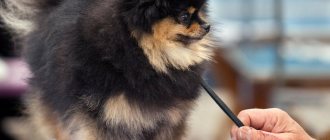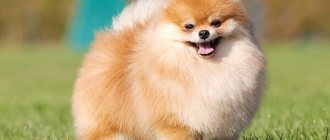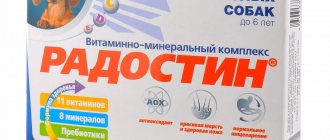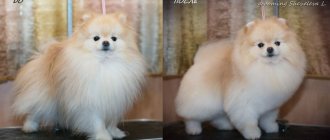Pomeranians are an absolutely picky breed when it comes to food. They will eat whatever they are taught to eat from childhood. The owner chooses what to feed the Spitz himself. You can turn your pet into a picky eater by spoiling him with a wide variety of foods. Or accustom him to a certain diet, which he will get used to and eat with pleasure.
Prohibited Products
If the diet of Pomeranians and other types of Spitz is based on natural products, it should be taken into account that not all of them are suitable.
What you should not feed your Spitz:
- Sausage, yeast baked goods, salted, fried, spicy foods, chocolate.
- Spicy beef bones due to the risk of intestinal damage.
- Chicken bones should not be given.
- Pasta, rolled oats, semolina porridge.
- Grapes, mushrooms.
Any boiled bones are contraindicated. They clog the intestines and are not digested.
Dry feeding
When deciding what to feed a Pomeranian, many people choose dry ready-made food. They are also called croquettes.
The advantages of the food are obvious:
- no need to combine diet;
- saving time;
- convenient to store;
- does not require additional minerals and vitamins.
However, what you should not do is feed your pet cheap food. They use vegetable protein, which cannot meet the animal's needs. And soy is a common cause of allergies. Corn is added to cheap drying. The ingredient saturates quickly, but is difficult to digest.
When choosing dry food for your Spitz, you need to pay attention to the following:
- The composition should not contain less than 25% protein. Protein (protein) must be of both animal and plant origin.
- The best dog food definitely contains meat, fish, liver, and protein derived from soy and alfalfa.
- Vitamins are an essential component of dry food. The composition should contain vitamins A, D and group B.
You don't have to worry about carbohydrates and minerals. These are cheap components, so every food for Spitz contains them in sufficient quantities.
These recommendations also apply to the choice of wet food. He eats it with pleasure. However, feeding your dog only canned food is very expensive.
Having decided what food to feed your Spitz, you need to follow the manufacturer's instructions for dosage and number of feedings. Veterinarians do not recommend frequently changing food for Spitz dogs without good reason. This may adversely affect the health of the animal.
For the breed, the best choice is super premium or holistic food. They are more expensive than drying from the supermarket, but the dog will be healthier from them.
The rating of the best premium and super premium food includes the following brands:
- Eucanuba
- Optima Nova
- Iams
- Nutro nuggets
- Pro Pac
- Happy Dog – hypoallergenic food
- Hills – for allergy sufferers
- Golden Eagle – hypoallergenic food
- 1st Choice
- Bosch
Holistic food for Spitz:
- Acana
- Orijen
- Innova
- Canidae
- Grandorf
- Eagle Pack Holistic
- Wellness
- Chicken Soup
Food for the Pomeranian Spitz, as for other varieties of the breed, is better to choose with a veterinarian or breeder.
When feeding dry food, it is imperative that the animal has access to water. It is better to hide the bag of granules. Spitz are gluttons. They may uncontrollably eat large amounts of dry food and harm themselves.
Feeding dry food
Dry food is convenient and hygienic, and when properly selected, it provides the Spitz with all the necessary substances in the right proportions. There are no useless or harmful components in premium, super-premium and holistic food.
Feed comparison
Pro Plan Small & Mini Adult Optidigest
Premium food Pro Plan for small dogs with sensitive digestion based on lamb meat and rice. It contains prebiotics and fiber, as well as corn, which can cause allergies in some animals.
Royal Canin Adult X-Small
Super premium food for adult dogs of small breeds. The source of protein is dehydrated poultry meat, contains yeast (a source of B vitamins) and fructooligosaccharides - prebiotics responsible for beneficial intestinal microflora. It contains corn - it should not be fed to Spitz dogs with a gluten allergy.
Eukanuba Adult Toy Breed
Contains 32% protein (poultry source), several types of grains (including wheat), prebiotics, vitamins, fatty acids and L-carnitine - a substance that regulates the dog's weight. You can see this and even more food from this manufacturer here.
Acana Adult Small Breed
Holistic food with a predominant protein content of animal origin (60%) and zero - grain and potatoes. “Fast” carbohydrates are replaced with seaweed, alfalfa and cranberries, which is useful for maintaining optimal weight.
You can choose high-quality and inexpensive food for your Spitz using the links below:
- Royal Canin Adult X-Small
- Acana Adult Small Breed
We also performed a detailed analysis of the following feeds: Proplan, Monje, Dog Chow, Brit.
When to change food
- your pet has moved from one age category to another and when the physiological state changes (pregnancy, sterilization),
- you notice signs of food allergies (diarrhea, scratching, “running” ears, skin rash), but be sure to consult a veterinarian,
- the food is incomplete (alopecia, dullness of the coat, brittle claws),
- are overweight (reduce the portion, if that doesn’t help, switch to holistic-grade food),
- The veterinarian prescribed a therapeutic diet.
Introduce new food into the diet gradually so that the digestive tract has time to “get used” to it and “establish” the production of the necessary enzymes.
Feed additives
When feeding dry food, it is not recommended to give additional multivitamins. In feed they are contained in concentrated form to prevent their loss during storage. Therefore, excessive doses of vitamins can be dangerous.
Additional supplements can only be prescribed by a veterinarian if the dog is sick, pregnant or raising puppies.
Food additives are a common cause of allergies. They should be given after consultation with a veterinarian.
Most often, Spitz dogs are given brewer's yeast, as it stimulates coat growth.
Red and brown dogs are fed seaweed. It is believed that it deepens the color of the coat.
Sea kale is not recommended for representatives of the wolf-colored breed, since the yellowish color of the coat is not welcome in this species.
Spitz breeds do not need mineral supplements as much as large breeds. They get everything they need from food. An excess of calcium disrupts the metabolism of minerals, which affects the condition of the teeth: baby teeth become very strong, so they do not allow permanent teeth to grow.
If the owner notes such a picture - the dog is licking the tiles, trying to gnaw on the walls, then he probably needs mineral supplements, which should be chosen in consultation with a veterinarian.
Ready-made dry food
Extruded feed
These are the usual ready-made dry food, which are often advertised in the media. These feeds are obtained from minced meat. The mass is extruded by heating and high pressure. With this effect, the protein molecule breaks down into smaller components. After such exposure, the pieces of food are treated with preservatives and flavor enhancers, and the pieces are dipped in an oily solution for long-term storage.
There are wet and dry ready-made diets. The only difference between them is their moisture content. So in wet food the moisture is 75%, and in dry food it is 15%. When feeding dry food, the dog should always have water available.
Feeding wet food
Holistic food
This food is produced by slow drying or drying. With this exposure, minced meat loses moisture, but the molecules remain intact. Flavor enhancers are not used. Such food is the most expensive and belongs to the premium class. Feeding a small Pomeranian is simple - he won’t be able to eat much, which means the cost of expensive food will be small.
Check out our line of holistic foods. On sale you can find wet food - holistic. They are packaged in iron cans and when served to the dog, pieces of meat and vegetables are visible, which is never found in extruded food.
Is it possible to mix
You can often hear that it is not recommended to change dry food throughout life and not to mix dry food with regular (natural) food. However, many breeders believe that alternating food from natural products with industrial food is acceptable. It’s just important not to mix them into one feeding. It is a mistake to believe that a mixture of porridge and croquettes will give the dog more benefits and fill it up faster.
You can mix wet food with kibble from the same manufacturer. However, there is a drawback - this significantly increases the cost of feeding.
There are canned foods into which it is permissible to add boiled cereals, usually rice porridge or buckwheat. It's written on the cans.
If your pet doesn’t eat one food well, you have to switch to another. This is done gradually. The digestive system does not adapt immediately. It will take several days. On average, the translation process takes a week.
Do you need variety?
Spitz, like other dogs, do not require variety. If you decide to feed your Spitz only dry food, it is not advisable to conduct experiments and test a new brand every week.
There are brands of dry food that have proven themselves. First, it is better to buy dry food for your Spitz in small quantities - for a week. If the croquettes are eaten with pleasure and do not cause digestive problems, you can feed them for another month. If the number of trips to the toilet does not increase, the pants are clean after a walk and the pet is happy with everything, leave the food.
If the dog does not eat well, they gradually switch to kibble from another manufacturer. If the Spitz does not eat dry food at all, then there is only one alternative - natural food.
The best dry food for Spitz
Dry food does not need to be cooked, it is stored for a long time and has a high energy value, but due to cooking at elevated temperatures, a significant part of the vitamins in the granules is destroyed. It is recommended to use formulations with reduced moisture in combination with natural food or during periods when it is not possible to cook for your pet. 4 of these foods are considered to be the most balanced and healthy.
Brit Care Venison for Small Breeds
This is a hypoallergenic food with a natural composition for small dogs with a sensitive gastrointestinal tract. 40% is venison - a dietary product that is many times healthier than lamb, pork, chicken and even beef. There are no parasites in it, so the meat is not subjected to high-temperature processing and thus retains most of the nutrients. Due to chicken and fish oil (3% each), the dog’s body is saturated with omega-3 and omega-6 acids, which improve well-being, mood and coat quality. Buckwheat and yellow peas are responsible for the energy value of the composition, giving the animal the necessary boost of strength for an active life.
Advantages
- High concentration of vitamins A, D3, E and C, which improve vision, strengthen bones and muscles;
- No harmful impurities or additives;
- Suitable even for picky dogs;
- All feed components are easily digestible;
- Normalizes digestion, immunity and stabilizes stool.
Flaws
- Not a low price.
Owners of picky dogs note that their pets happily eat only Brit Care. They report that after prolonged consumption of food, dogs stop lacrimation and gastrointestinal functions are restored.
Chappi beef
Chappi Spitz dry food is based on cereals - it is a source of carbohydrates and strength for the dog, but the percentage and type of cereals are not indicated on the packaging. The second highest protein content here is in the form of beef and offal. Analyzes showed 18% meat composition, which is not too much. The slight lack of protein components is compensated by the affordable price of the product; a 15 kg package costs about 1000 rubles. The composition also includes animal fats and vegetable oils, which promote the absorption of nutrients in the body and increase immunity. The food contains a sufficient amount of fiber and mineral components.
Advantages
- Present on the shelves of most stores;
- Affordable price;
- Positively affects the condition of the coat;
- Causes a good appetite;
- Most dogs like it.
Flaws
- Small concentration of vitamins;
- There is no information about the percentage of key components;
- The basis of the feed is cereals.
Chappi has a cheap, but not the most balanced composition due to the small amount of proteins. Therefore, in addition, it is better to feed the dog with meat products and give vitamins.
1st Choice Adult with chicken for small breeds
This is a super premium chicken-based food designed for small adult dogs weighing up to 9.5 kg. Spitz likes poultry meat, so most dogs have an excellent appetite. The formula is based only on products that are easily digestible (there is no wheat, soy, corn or other “heavy” additives). Natural vitamin E is used to preserve the product; there are no dyes or other additives in the composition. All of the above has a positive effect on maintaining the dog’s normal physical shape and weight.
Advantages
- Natural fiber improves digestive function, preventing fat deposition;
- Green tea supplement helps improve oral and dental hygiene;
- Has a bactericidal effect and freshens breath;
- Yeast and chicory extracts help develop healthy microflora;
- Increases immunity;
- Reduces gas formation.
Flaws
- High price;
- It is not always available in retail stores; you should look for it in large hypermarkets.
1st Choice Adult food fully satisfies the Spitz's needs for vitamins and amino acids, which has a positive effect on the animal's well-being, improves the condition of the coat and helps strengthen immune function.
ALL DOGS dry complete
This is a budget food that costs about 1800 rubles. for 20 kg and is suitable for complete nutrition. It contains omega-3 and omega-6 fatty acids, which make the skin healthy and the coat beautiful. The composition does not contain GMOs, soy and dyes, which improves oral hygiene; the granules are based on cereals, meat and offal. Their long-term use improves vitamin and mineral balance and digestive function. However, active dogs may be deficient in nutrients, so it is better to feed them natural foods and give them vitamins.
Advantages
- Hypoallergenic composition at an affordable price;
- Dogs eat with pleasure;
- Healthy coats in dogs that have been eating food for years;
- No harmful additives;
- Sold in most stores.
Flaws
- There is no complete information about the composition - a characteristic feature of economy-class feed;
- Not too many nutrients.
The ALL DOGS complete mixture includes all the basic components for the life of dogs, but it is slightly lacking in vitamins. Due to its safety and quick satiation of the pet, it is one of the best foods for Spitz in the inexpensive segment.
Puppy food
When a puppy is with its mother, it begins to eat as soon as it wakes up. As the kitten grows, how much to feed the kitten per day is determined and controlled by the breeder.
A lactating bitch can feed puppies. She regurgitates the food she eats, which the babies eat with pleasure. This is a normal process that should not be interfered with.
When a kitten appears in the house, at first you need to feed the Spitz puppy according to the pattern to which he was accustomed. If this schedule is not satisfactory, then it is changed gradually.
Spitz feeding varies by month:
- The puppy is taken from its mother at the age of 1.5-2 months. A two-month-old baby is fed 4-5 times a day. At the same time, for the first time it is better to use the same food for a Spitz puppy as that provided by the breeder.
- After a month, it is recommended to feed the puppy up to 4 times a day. If the pet refuses to eat, then reduce the size of the portions, but not the number of feedings. The puppy's stomach is small - so that food is digested, it is given often and in small portions.
- From 4 to 6-7 months, puppies need to be fed at least 3 times a day.
To find out when to reduce the number of feedings and how many times to feed your Spitz, you need to monitor the puppy. If he becomes hungry before the next meal or constantly runs to the bowl and sniffs it, it is too early to reduce the number of feedings.
If at the next feeding the dog approaches the bowl without enthusiasm, is reluctant, eats poorly, selectively chooses pieces, then you can feed it twice a day. The same goes for portions. If the dog quickly eats everything and goes about his business, the amount of food is sufficient.
If the pet does not move away from the bowl and licks it, the portion is increased. This applies to both puppies and adult dogs.
When deciding which food is best for a Spitz puppy, it is important to consider its consistency. You cannot feed your dog only soft food.
At 3-4 months, a puppy can easily be accustomed to any food: both natural and dry food. This is much more difficult to do in adolescence. After a year, an untrained dog no longer refuses to accept fermented milk products, vegetables, fruits, eggs and fish. Therefore, it is important to teach your Spitz to be an omnivore at an early age. This will only be beneficial in the future. For example, during periods of illness, after illness or surgery, dietary nutrition is required. If the dog is not trained to eat everything, then such a transition can cause serious stress.
Feeding pregnant and lactating bitches
It should provide the bitch with increased needs for energy, building materials, vitamins and microelements, which she spends on the intrauterine development of fetuses and feeding puppies. The number of daily feedings is increased to three times or more (~ from 5 months). The amount of food should be increased through proteins, not carbohydrates.
If the bitch is on dry food, transfer her to the “puppy” line; if it’s natural, add vitamins, offer fruits and vegetables, dairy products, monitor freshness. You cannot add vitamins to dry food! For example, excess vitamin A will lead to malformed fruits. Feed lactating bitches in the same way as puppies in the second half of pregnancy.
Nutrition rules
In order for the animal to be healthy and cheerful, you need to follow certain recommendations on how to feed your dog correctly:
- Always feed your pet after a walk - this is an important rule. As a last resort, he should eat 2 hours before going outside.
- An adult dog is fed at the same time - morning and evening, a puppy - at equal intervals.
- Despite being omnivorous, you should not feed your Spitz human food from the table.
- It is permissible to soak dry food in water for a Spitz puppy, accustoming it to this type of food. This is not done to an adult dog. Dry granules, in addition to satiation, perform another function - when a dog chews them, its jaws work, the blood supply to the teeth improves, and plaque is cleared.
- When feeding a natural diet, it should be taken into account that the quantity and composition of food varies depending on the age of the dog and the time of year. So, in winter a Spitz needs more food than in summer. During the molting period, vitamins and microelements are necessary for beautiful fur.
It happens that animals vomit after eating. If this happens once, about 20-30 minutes after eating, you should not be alarmed - this is the norm.
If the dog does not eat dry food and refuses homemade food, there is no need to force feed it. This is probably a sign of illness and it is best to contact a veterinarian.
What to feed a Spitz puppy
If you are feeding your puppy yourself, use a bottle with a nipple rather than a dropper. Do not use pure cow's milk or infant formula. If you buy a puppy, for the first week and a half, until he gets used to his new habitat, feed him what he is used to.
Change his diet, gradually increasing the share of new food and decreasing the share of old food. It takes one month. If the food is chosen correctly, the pet will be cheerful and active, its coat will be shiny and smooth. From the age of 8 months, a Spitz is considered an adult dog.
Determine the frequency of feedings based on the age and growth rate of the dog. During a growth spurt, your puppy's appetite increases. During this period, he can be given a supplement.
| Age, months | Frequency of feedings, once a day |
| up to 1 |
|
| 1-2 | 6 |
| 2-3 | 5 |
| 3-6 | 3-4 |
| 6-8 | 2-3 |
| from 8 | 2 |
Young Spitz dogs need very small portions. Amount of food they require (approximately):
- 1/4 cup - for a puppy weighing 0.4 kg;
- ~ 1/2 cup - 0.8-1 kg;
- 1 cup - 1-2 kg;
- 1 1/2 cups - more than 2 kg.
The menu for a Spitz puppy also depends on the age of the dog.
| Age, months | What to feed |
| up to 1 |
|
| 1-2 |
|
| 2-3 |
|
| 3-6 |
|
| 6-8 |
|
“Natural” is preferable to “dry” for young dogs, as it accustoms them to different tastes and more easily arouses food interest.
Do not disrupt the puppies' diet! They have a very fast metabolism, which means increased glucose consumption. When there is a lack of it in the blood (hypoglycemia), the brain suffers, the dog becomes lethargic and may fall asleep. If this happens, give her an injection of glucose or pour sweet water into her mouth, but it is better to make sure that the puppy eats.
Here is the opinion of the puppy's owner on how to feed small Spitz dogs.
Spitz need to chew
During teething, young animals also need to chew on something. This helps develop and strengthen teeth and jaws. When puppies chew on something elastic, their baby teeth are quickly replaced by permanent ones.
An adult pet always has the need to chew - this is at the same time massage of the gums, cleaning of the teeth and exercise for the jaw. It’s also a way to relieve dog stress. The Spitz's dental apparatus, unlike other breeds, is not as strong, so it requires training. For this purpose, chicken neck or legs are given.
A regular large bone will do. But you need to be sure that the dog will not bite off a sharp piece from it, which can cause serious harm and even kill the animal. Therefore, small and medium bones are not given. Moslaks from a bull or cow are suitable for these purposes. They are used for the teething period, but no more. Natural bone, if chewed frequently, has abrasive properties and leads to damage to tooth enamel.
Caution should be exercised when handling rawhide and pressed leather bones. Dogs often swallow pieces of skin. They swell from saliva and gastric juice and can cause suffocation and intestinal obstruction. Products made from cast rawhide are safer.
An excellent option would be nylon bones, which Spitz chew with pleasure. Their jaws are always at work, and the owner’s belongings are intact. Nylon products are safe and durable, and therefore economical.
How to check fatness
There is a way that allows you to check whether the dog’s weight is normal or if there are deviations. Place your hand on your ribs:
- If a layer of fat (about a few millimeters) is palpable between the ribs and skin, the dog is of normal weight.
- If only the chest is felt, you should feed your pet.
- And if the fat layer is 1 or more centimeters, you need a vegetable diet.
Spitz dogs love to eat, so they quickly gain weight. Getting rid of obesity is not easy. Therefore, initially you should not overfeed your pet.











